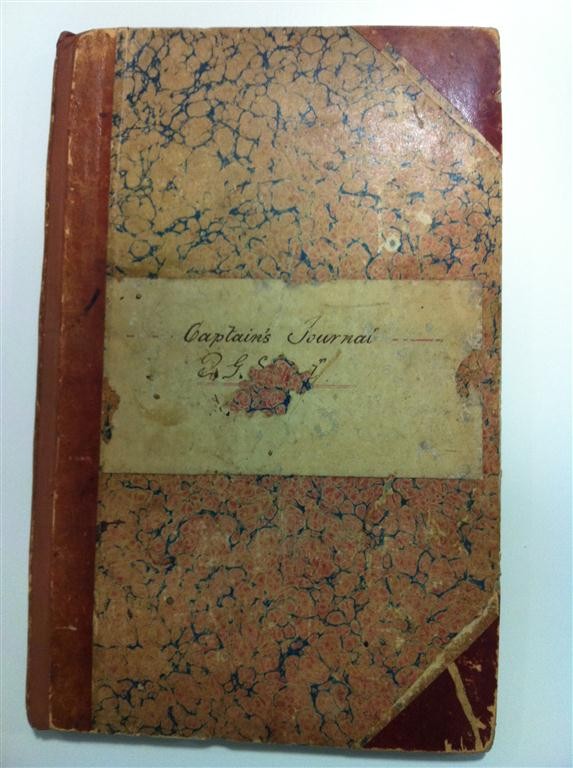
On 23 July 1879 Captain Charles Edward de Fonblanque Pennefather set off aboard the Queensland Government Schooner (QGS) ‘Pearl’ on an expedition to the Torres Strait. His assignment: to advise the Indigenous populations that the Islands would now be administered by the Queensland Government. Just two days prior the ‘Queensland Coast Islands Act 1879’ had been announced, described as ‘an Act to provide that certain islands in Torres Straits and lying between the continent of Australia and the island of New Guinea shall become part of the Colony of Queensland and subject to the laws in force therein’. This Act superseded 1872 legislation, extending Queensland’s borders to within a few hundred metres of Papua New Guinea. The boundaries, as outlined in ‘Queensland Coast Islands Act 1879’, still exist to the present day.
Pennefather kept a journal of this voyage, which commenced at Port Office Wharf in Brisbane and continued up the Queensland coast. Several stops were made, including at Whitsunday Island where two Aboriginal women in a canoe came alongside the ship wanting to sell coral and shells. At Margaret Bay, near Cape Grenville, Pennefather made an unwelcome landing, encountering an elderly Aboriginal man (not named). When describing the place Pennefather records:
…a delta of salt water creeks and mangrove swamps through which we ploughed our way being devoured all the time by green ants evidently much to the old black fellow’s satisfaction, who insisted to lead us to the worst places he could find…

Upon reaching the Torres Strait Pennefather visited many islands delivering the message of Queensland administration. His journal fails to document the reaction of Torres Strait Islanders to this news.
Friday 14 November
Landed and mustered natives of Yorke Island (native name Macheek ) informed them that the island was annexed within the Colony of Queensland and that they would be held responsible for their actions. Yorke Island is thickly timbered but the soil is poor, the natives subsisting principally on fish, turtle etc, the later were very plentiful about the island. Noon weighed and made sail, it falling calm, had to let go again to avoid drifting on a reef.

Also on board the Pearl was Inspector William Armit (1848-1901) and a contingent of six armed troopers, bound for Somerset, on Cape York Peninsula, to patrol for and 'deal with' recent conflicts with the Aboriginal people. Armit's association with the Native Police is well known and his dislike of Aboriginal people well documented. On their voyage north, on 20 August 1879, the ship anchored at Margaret Bay, north of Cape Grenville, where Pennefather and Armit landed to investigate reports of a white woman living among the local tribes, without success. When the ship anchored off Thursday Island, 22 August he noted HMS Beagle was also in port, having recently returned from New Guinea. The captain reported that the mission steamer Ellengowan had been attacked at Cloudy Bay; much retribution was later carried out by the officers and men of HMS Beagle. There are many themes contained within this narrative, much to do with the subjugation and distrust of the Aboriginal, and Torres Strait Islander people, as Europeans sought to establish themselves and the colony of Queensland.
One task Pennefather completed when landing on any of the Torres Strait islands was to make notes of the population, describe the island's suitability for cultivation, and comment on the native people's intelligence and society, not all complimentary. Information recorded by Pennefather about each island include; population, landscape, food and water sources, conflicts, missionary inhabitants, pearl-shelling and bêche-de-mer fishing operations. The bêche-de-mer fishing and pearl shelling industries began in the Torres Strait in 1860 and led to an influx of people from all over the region. Pennefather’s journal reflects this, recording South Sea Islanders, Malaysians, West Indians and Europeans among the Islands inhabitants. The establishment of these industries brought about forced labour, violence and abductions in the Torres Strait.
Upon visiting Mabuiag (Jervis Island) Pennefather states:
This Island being in the middle of the shelling ground is the rendezvous of all the boats in the Straits at times, and I cannot sufficiently condemn the practice of giving the crews or allowing them to buy unlimited quantities of spirits. This has been the source of many of the rows which have occurred and will possibly someday account for some horrible massacre among the whites, as the crews are very little better than savages both South Sea Islanders and Malays.

After this entry the QGS Pearl set sail for Thursday Island and the journal entries cease. From Thursday Island Captain Pennefather made a voyage to Papua New Guinea and in June 1880 was instructed to explore the coast and rivers of the Gulf of Carpentaria. A river in this area was later named in his honour, Pennefather River.
Captain Pennefather was appointed first ‘Police Magistrate and inspector of Pacific Islanders’ at Ingham in 1882 and in 1888 accepted the position of superintendent at St. Helena. In 1893 he was appointed Comptroller-General of Prisons, a position Captain Pennefather held until he retired from public service in 1919 at the age of 71.
Charles Edward Pennefather Journal is held at the John Oxley Library and is available to the public. You can read a digitised version of the manuscript here.
References
- Queensland Coast Islands Act 1879
- Woven Histories, Dancing Lives: Torres Strait Islander Identity, Culture and History, page 156.
- OM72-59 Charles Edward Pennefather Journal 1879, page 10
- OM72-59 Charles Edward Pennefather Journal 1879, page 18
- http://www.datsima.qld.gov.au/resources/atsis/everybodys-business/protocols-torres-strait-islander/section1-part1.pdf
Comments
Your email address will not be published.
We welcome relevant, respectful comments.